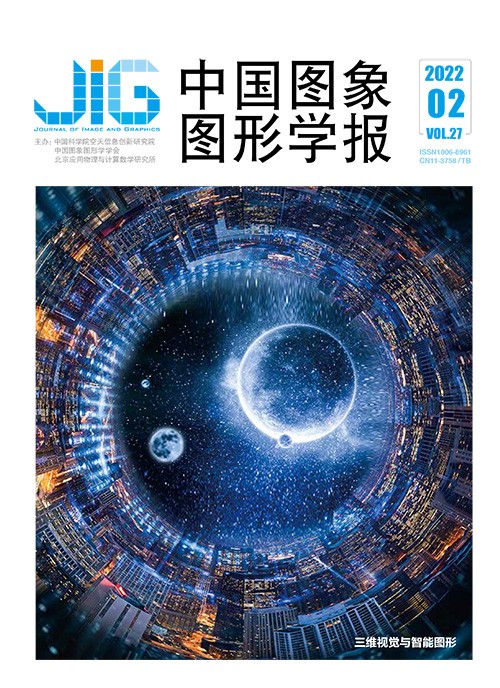
显微光学模糊图像的景物深度提取及应用
摘 要
目的 显微光学成像有景深小和易模糊等缺陷,很难根据几何光学中的点扩散函数准确评估图像的模糊程度,进而很难计算景物深度。同时,传统的使用边缘检测算子衡量图像模糊程度变化的方法缺少与景物深度之间的函数关系,影响深度计算的精度。为此,本文提出一种显微光学系统成像模糊程度与景物深度关系曲线的获取方法。方法 从显微光学系统中的光学传递特性出发,建立光学传递函数中的光程差、高频能量参数和景物深度之间的数学关系,并通过归一化和曲线拟合得到显微光学系统的成像模糊程度与景物深度之间的解析函数。结果 为了验证本文获取的图像模糊程度和景物深度之间的函数关系,首先使用纳米方形栅格的模糊图像进行深度计算,实验测得的深度平均误差为0.008 μm,即相对误差为0.8%,与通过清晰图像和模糊图像的逐个像素亮度值比较,根据最小二乘方法搜索两幅图像的亮度差最小时求得深度的方法相比,精度提高了约73%。然后基于深度测量结果进行模糊栅格图像的清晰重构,重构后的图像在平均梯度和拉普拉斯值两个方面都明显提高,且相对于传统基于高斯点扩散函数清晰重构方法,本文方法的重构精度更高,稳定性更强;最后通过多种不同形状和亮度特性的栅格模糊图像的深度计算,证明了本文的模糊程度—深度变化曲线对不同景物的通用性。结论 本文建立的函数关系能够更加直观地反映系统参数对光学模糊成像过程的影响。使用高频能量参数表征图像的模糊特性,既可以准确测量图像模糊程度,也与景物深度具有直接的函数关系。固定光学系统参数后,建立的归一化系统成像模糊程度与景物深度之间的函数关系不会受到景物图像的纹理、亮度等特性差异的影响,鲁棒性强、更方便、更省时。
关键词
Scene depth extraction and application of microscopic optical blur image
Miao Guochao, Wei Yangjie, Hou Weihan(School of Computer Science and Engineering, Northeastern University, Shenyang 110004, China) Abstract
Objective In micro-optical imaging, the depth-of-field is small, and the image easily becomes defocused. However, accurately evaluating the blur degree of the image according to the point spread function in geometric optics and then calculating the depth of the scene is difficult. Although the traditional method applies edge detection operators to measure the change of the image blur degree, these operators evaluate the blur degree of the image according to the change speed of the edge brightness, no direct mathematical relationship with the system parameters and the depth of the scene exists, and a mathematical model of the relationship between image blurriness, optical system parameters, and scene depth accurately cannot be established. In addition, the evaluation value of blurring degree is closely related to image features such as scene texture and brightness; hence, their robustness is poor. More importantly, in microscopic imaging systems, the effect of light diffraction and refraction is remarkable, and the optical system parameters on the imaging quality are complex and mutually coupled. Most of these evaluation methods are based solely on image characteristics to achieve fuzzy evaluation, without considering the parameters of the optical system, and accurately reflecting the overall characteristics of these systems is difficult. Therefore, studying the quantified and generalized relationship model between the degree of image blur, the depth of the scene, and the systematic parameters based on the transmission characteristics of light in optical imaging is necessary to restore scene depth information and reconstruct the focused images. Method A general defocused-depth model for optical microscopy systems is proposed in this paper. First, starting from the optical transfer characteristics in the microscopic optical system, the mathematical function relationship between the optical path difference in the optical transfer function and the depth of the scene is established, and the influence of the optical path difference on the optical transfer characteristics is analyzed, that is, the high-frequency response of the optical system is gradually attenuated as the optical path difference increases. According to the composition characteristics of optical imaging, the outline of an image is determined by low-frequency signals, the image details are determined by high-frequency signals, and the loss of image high-frequency signals means image blur. Then, the high-frequency energy parameters are introduced to describe the blur degree of the image. To obtain the high-frequency energy of the image, first, high-pass filtering is performed on the image to obtain a frequency-domain image that only contains the high-frequency information of the image. Then, the sum of the pixel values of the spatial image is calculated by using its inverse Fourier transform to obtain the high-frequency energy parameters of the image, and the mathematical function relationship between the high-frequency energy parameters and the depth of the scene is established through the optical transfer function. Finally, a general fuzzy depth model of the microscope optical system is obtained through normalization and curve fitting. Result To verify the defocused depth model of the optical system proposed in this paper, first, depth calculation is performed using the blurred image of the nano square grid. The average error of the depth measured in our experiment is 0.008 μm, and the relative error is 0.8%. Compared with the pixel-by-pixel brightness value comparison method based on the least squares principle, accuracy is improved by approximately 73%. Based on these measurement results, the focused image reconstruction of the blurred grid image is performed. The reconstructed image has a substantial improvement in average gradient and Laplacian value. Compared with the traditional clear reconstruction method based on Gaussian point spread function, the reconstruction accuracy of our method is higher, and the stability is stronger. Finally, the versatility of the blur degree-depth curve to different scenes in this paper is proven through the depth calculation of the striped grid blurred image and the focused image reconstruction. Conclusion The functional relationship established in this paper can more intuitively reflect the influence of system parameters on optical blur imaging. Using high-frequency energy parameters to characterize the blur characteristics of an image can only measure the degree of image blurring accurately and has a direct functional relationship with the depth of the scene. More importantly, with the fixed parameters of an optical system, the functional relationship established between the normalized system imaging blur degree and the scene depth in this paper is not affected by variation of image texture and brightness. Therefore, it is robust, convenient, and time saving in real applications.
Keywords
optical microscopy system blur degree scene depth analytic function optical transmission characteristics high frequency energy parameter
|



 中国图象图形学报 │ 京ICP备05080539号-4 │ 本系统由
中国图象图形学报 │ 京ICP备05080539号-4 │ 本系统由